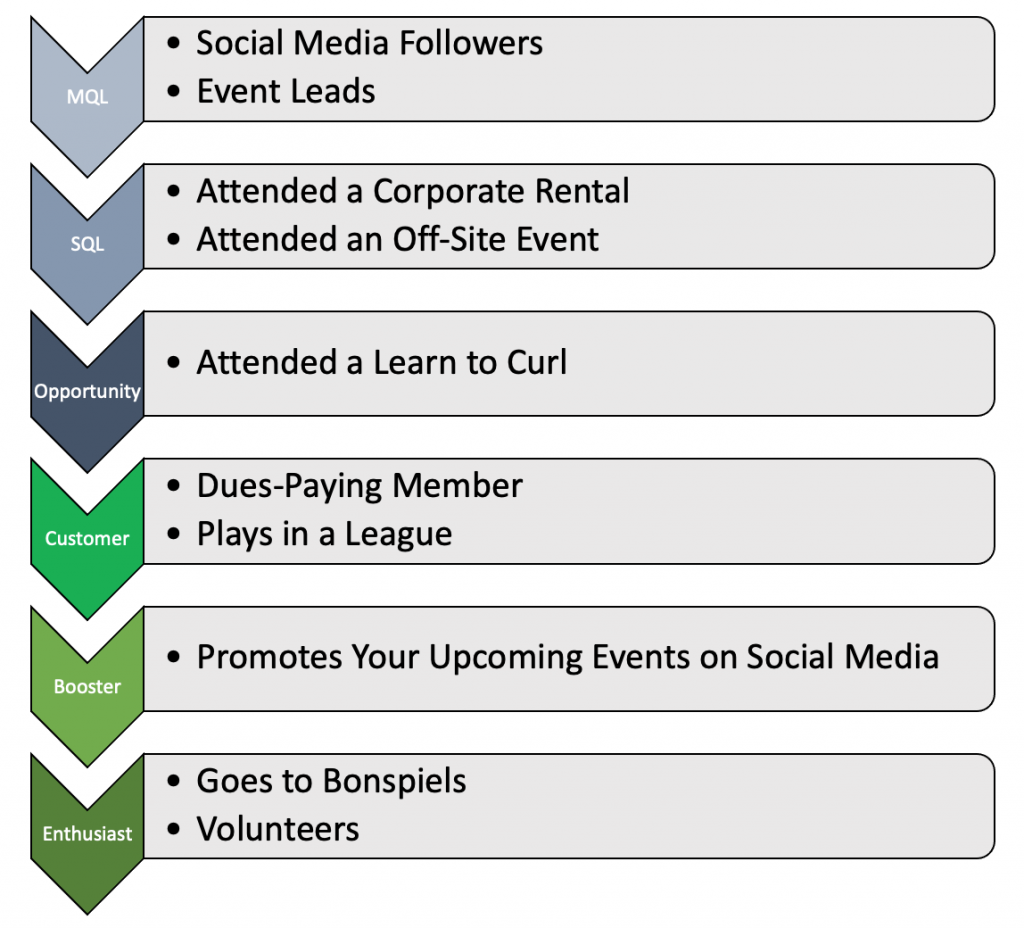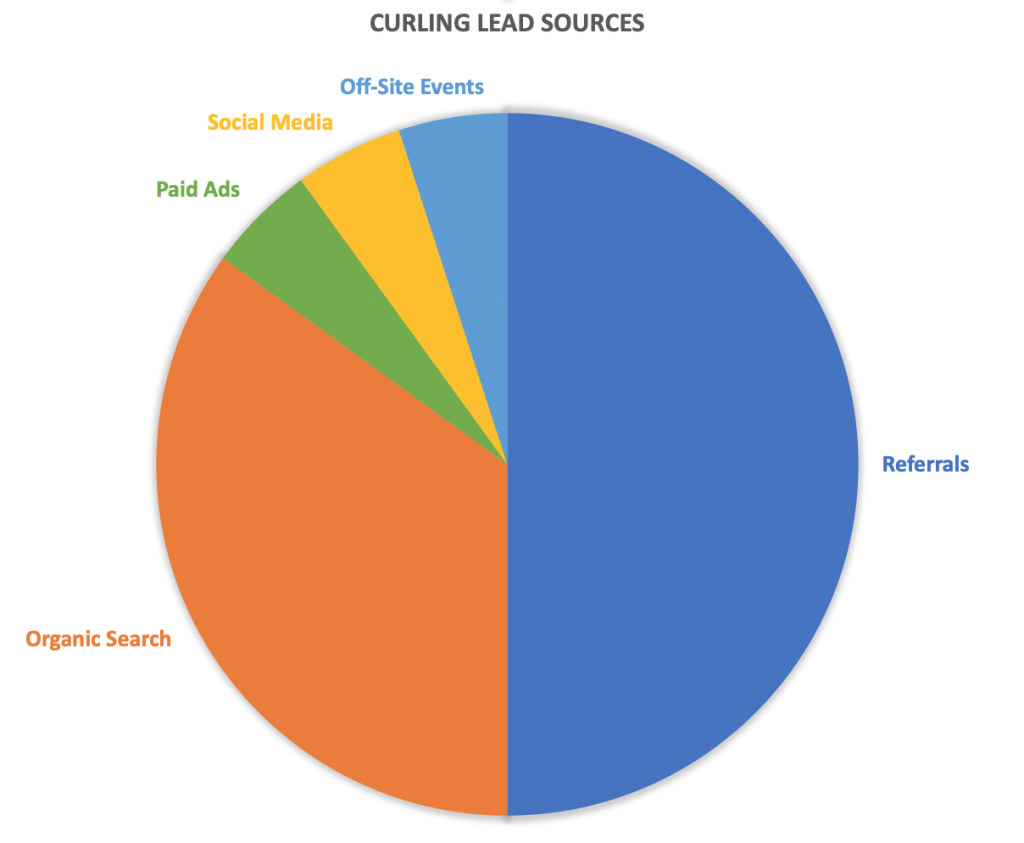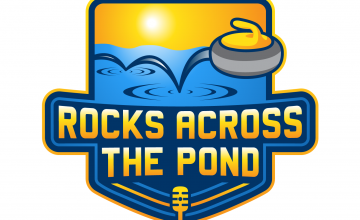Curling is in the process of maturing as a sport, going from amateur to professional. As we’ve talked about on Rocks Across the Pond, the sport has experienced growing pains since officially becoming part of the Olympic program in 1998.
When we’ve talked about this professionalization process, we’ve mostly talked about it from the high performance level. However, these growing pains are beginning to be felt at the grassroots level as well.
As curling matures and professionalizes, those of us at the grassroots level need to do the same in our approach to growing the sport by recruiting and retaining new curlers.
The Traditional Sales Funnel
If you’re part of a sales organization, you’re probably familiar with how sales leads flow through the traditional funnel. Most of the time, the sales funnel looks something similar to this:
- Visitors
- Leads
- Marketing Qualified Leads (MQLs)
- Sales Qualified Leads (SQLs)
- Opportunity
- Customer
Marketing brings in leads. Then, the junior sales staff combs through those leads. The ones ready to purchase are passed on to the senior sales staff. Hopefully, that staff then closes deals. Even if you haven’t been involved in taking potential clients through that funnel, you may have traveled through that funnel yourself whether you realize it or not.
But can the traditional sales funnel be applied to curling? I believe it can. And organizations at the grassroots level need to start thinking in these terms if they want their organization to continue to grow.
Applying the Sales Funnel to Curling
We don’t necessarily need all of the stages when we think about our curling pipeline and sales funnel. Here’s what I think curling’s sales funnel looks like:

We’ll get to those last two in a minute. But first, let’s look at the curling funnel leading up to the sale.
MQL: This is the highest level of your funnel. It includes people who have interacted with your organization on a basic level. They liked you on Facebook. They subscribed to your newsletter. They filled out a form when you had a marketing table at a local festival.
SQL: These are people who have had a more personal interaction with you. They were part of a corporate rental. They joined you at a local brewery to watch curling on TV. However, they probably still haven’t given you any money.
Opportunity: This is one step away from joining. For the most part, this will include people who came to a Try Curling event. There’s more buy-in because they’ve experienced the sport and there’s been a financial transaction.
Customer: One of us! One of us! One of us! They’re a part of our organization and are likely playing in a league.
I recognize it’s impersonal to think of our potential curlers in these terms. But if you apply the stages of the traditional sales funnel to what we are trying to do to grow curling, we can better understand how we can move curling leads through our curling sales pipeline.
How Do We Get New Curlers in Our Funnel?
Back when I was managing the marketing department at a B2C (business to consumer) company, I was in charge of bringing in our sales leads. Because we were in a service industry, I felt it was important for the majority of our leads came from referrals.
If referrals were low, it meant our customers weren’t satisfied with us.
But it was also a balancing act. If referrals were too high, it meant I wasn’t doing my job by supplementing our lead pipeline with marketing leads.
At the end of the day, I wanted our referrals to represent somewhere between 50-60% of our leads.
The same applies to curling. A healthy curling organization is getting a majority of its new members from referrals. Word of mouth is the cheapest, and still the best, form of marketing. Any sales organization knows the highest-converting sales leads are referrals and always will be.
But we can’t rely on referrals, especially today. Curling has to become more diverse and in order to do that we have to look at different ways we can bring potential curlers into our funnel.
How Do We Diversify Our Lead Sources?
A healthy leads pipeline can’t rely on just one source. And I think the modern curling leads pipeline needs to look something similar to this:

Notice corporate rentals aren’t included. There’s a reason for that. Those rentals heard about you somewhere. Odds are they fit into one of these common lead source types.
The bad news is I don’t think curling can rely totally on referrals anymore. The good news is you don’t need a massive budget to diversify your leads pipeline.
As I said before, the highest converting lead source is referrals. Well, the next-highest converting lead source is organic search. If you make it easy for people to find your website, put good content on there and make it easy for people to get in touch with you, you’re doing great.
Social media is a low-converting lead source, but it’s free. It has the added bonus of helping with your visibility in your community.
The two common lead sources that are going to cost money are paid advertising and event marketing. Even with an extremely small budget, it’s possible to reach a large number of people if you’re smart about where you spend your money on advertising and events. And some events, like a school visit, aren’t going to cost you anything (even if you are going to get very few curlers out of it, at least immediately).
How Do We Nurture Our Curling Leads?
If you’re a part of a sales team, here’s another term you’re already familiar with: Lead nurturing. If you’re not, it simply refers to the touch points we use to move leads through the funnel and toward a sale.
For curling organizations, this probably means contacting your mailing list to let them know league registration is open. But this isn’t enough anymore. We’ve already talked at length about why your curling organization needs a newsletter.
It’s because of touch points. The typical sales cycle requires 10 touch points before someone is ready to make a purchase. How many times do you reach out to those on your mailing list, especially those who come to a Try Curling event? Do they just get the “registration is open” email?
Does your club have a volunteer who is in charge of development? Can they spend two hours calling the 20 people who came to your last Learn to Curl to give them a more personal touch point? Or better yet, can that list be divided among your Learn to Curl volunteers so they call the 4-5 people they personally taught to curl last week?
This is also a great way to get feedback on what worked and what didn’t to improve your future events.
Don’t Just Nurture Your Leads, Nurture Your Customers
Let’s think back to that previous graphic that showed our curling sales funnel. What were those last two segments? It was Boosters and Enthusiasts.
Booster: They’re sharing information on upcoming leagues and Learn to Curls with their friends.
Enthusiast: They’re completely bought in. They bought shoes and one of those fancy brooms that are illegal at WCF events. They go to bonspiels. They teach Learn to Curls. They serve a term on the board of directors.
Healthy curling organizations don’t just know how to convert potential curlers into curlers. They know how to convert their current curlers into enthusiasts. These are your best members and they’re the ones who are going to bring in referrals. Those cheap, high-converting leads.
If you’re desperate for referrals, you can come up with a program that incentivizes them. Give a gift card to a member who refers a new member. Or at the end of each league season, put all your referring members into a hat and have a drawing for a new broom.
But by far the best way to grow your boosters and enthusiasts is to maintain a positive culture at your organization. Walk the walk when it comes to making your organization a fun, inviting, inclusive environment. No matter their age, gender, race or whether or not they drink.
That’s the easiest, cheapest way to fill our pipeline with quality leads that turn into new curlers in our curling sales funnel.
Bring This to Your Organization
Your members are your best resources. You probably have someone in one of your leagues who’s day job involves this same sales process. Ask them how your club can start applying traditional sales principles to your recruiting and retention.
Ryan is a marketing professional and a member of Curling Club of Virginia. He spent 12 years in marketing and media relations in sports and live events, including time with a Major League Baseball club. How well does your curling club turn potential curlers into new members? Tell us at rocksacrossthepond@gmail.com.
How your curling club can get more organic traffic
5 easy email marketing tips to help grow your curling club
Email Rocks Across the Pond
Like us on Facebook
Follow us on Twitter
